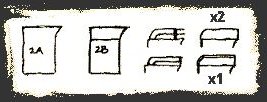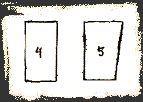| Section Page | Previous Page | Next Page |
GWR bunker styles (for small engines)by Mikkel Kjartan
The many different bunker styles on GWR tank engines can be rather confusing, so here is a brief description of the major types. Note that these are in principle only the designs used on the smaller four-coupled tanks, but the basic styles are widely applicable to other tank classes also. The drawings and data below are based closely on "Locomotives of the Great Western Railway, Part 6" by the Railway Correspondence & Travel Society (now out of print). Many thanks to David Bell for helping with the page. Any errors are those of the author only.
Early bunkers were made from iron, and had sloping fronts (1A). Some were later altered to the square front version (1B). In due course, fenders of various designs were added, as seen on the right.
In 1878, new steel bunkers were introduced in Wolverhampton works (2A). Some had a prominent joint beneath the flared tops (2B). The design was adopted by Swindon in the 1880s, and was developed further with the addition of coal rails and/or fenders as shown here. From circa 1906, a standard design for this type had been arrived at (x1), and this was used widely on the smaller tanks until grouping in 1923. A few were given deeper fenders during WWI (x2).
The 517 Class and related 0-4-2T's were mostly built at Wolverhampton works, and were turned out with their own bunker style during the 1884-1915 period (3A). In order to increase coal capacity, make-up pieces were often added (3B & 3C). A few had actual replacement bunkers fitted during WWI (3D), while locos with enclosed cabs had a square-front version (3E & 3F).
The rather austere "coal-box" (4) appeared first in 1886, and was subsequently used especially on the larger eight and ten-wheeled tanks. The similar type with sloping back (5) was used on the experimental oil-burning "101" around the turn of the century, but also on the Churchward 1361 dock shunters of 1909.
Around WWI there was a need for increased coal capacity, but the war left little time for implementing new designs. Some of the larger eight and ten-wheeled tanks did recieve enlarged bunkers at this time (6C & 6D), but apart from a few replacement bunkers (6A), the smaller tank engines did not generally see any bunker changes until grouping. In 1924, Wolverhampton works developed a deeper version of their original pattern (2C), while Swindon took an outset in the designs developed earlier for the larger tanks (6B, 6C & 6D). These soon became widespread on new tank classes also, (such as the various versions of the 57xx class) and essentially lasted in different sizes until grouping. |
| Section Page | Previous Page | Next Page |




